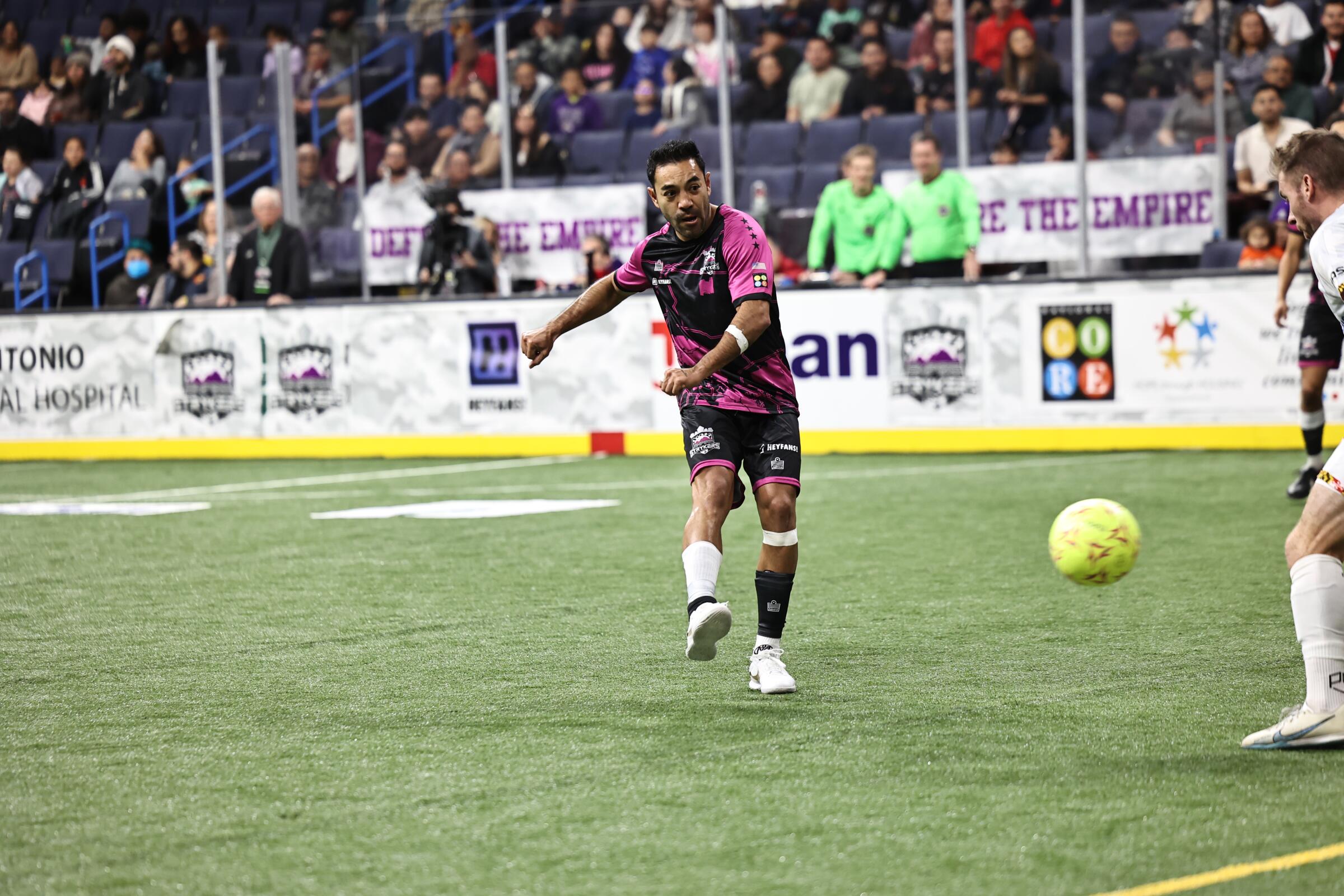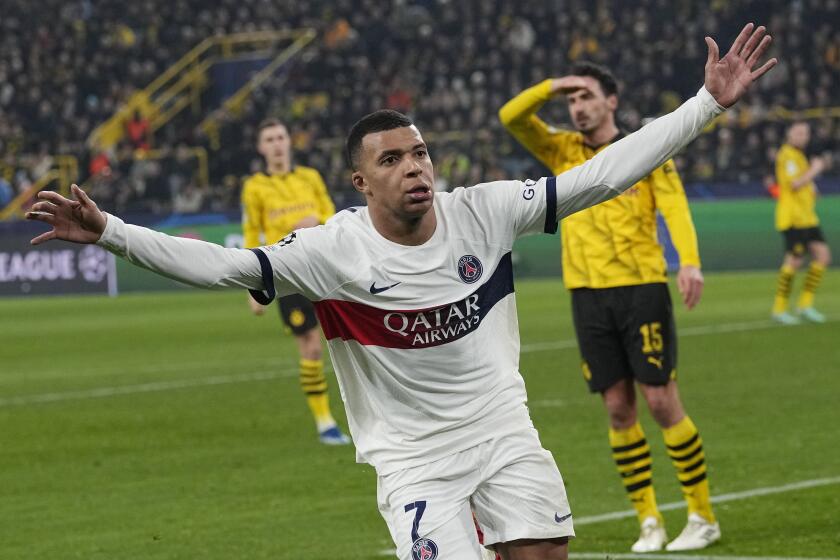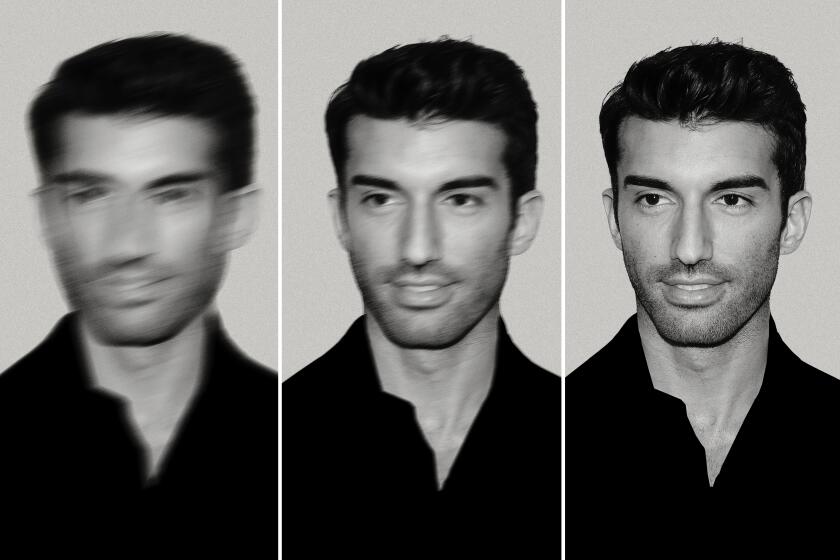Kevin Baxter writes about soccer and hockey for the Los Angeles Times. He has covered seven World Cups, five Olympic Games, six World Series and a Super Bowl and has contributed to three Pulitzer Prize-winning series at The Times and Miami Herald. An essay he wrote in fifth grade was voted best in the class. He has a cool dog.
- Share via
1
Four and a half years ago Marco Fabian was playing in his second World Cup for Mexico, which opened the tournament by beating top-ranked Germany before more than 78,000 fans in Moscow’s massive Luzhniki Stadium.
Last Wednesday, Fabian was playing in his third Major Arena Soccer League game for the Empire Strykers, who lost to the Tacoma Stars before 2,001 fans at the spartan Toyota Arena in Ontario.
In Russia, and in the German Bundesliga before that, Fabian played on lush grass carpets manicured for soccer. In Ontario, he played on a real carpet, one laid out in pieces over a hockey rink. But if you’re tempted to feel sorry for him, Fabian would urge you to save your pity.
Tottenham goalkeeper Hugo Lloris, who has appeared in 20 World Cup matches, has agreed to play for LAFC for a low price.
“I am 100% happy,” he said with a smile. “I really enjoy every day. I lost a little bit this emotion about soccer. And now I start to feel [it] again.”
There’s more to Fabian joining the Strykers last month than the player’s happiness. For team owner Jeff Burum, who four months ago was unanimously voted president of the MASL, the signing could prove to be the league’s David Beckham moment, one which will forever separate its past from its future.
Whether or not the gamble pays off will depend not only on Fabian’s playing ability, but on his ability as a recruiter because for it to work, Burum needs the former Chivas and Eintracht Frankfurt standout to lure some former teammates to the MASL. The first of those could arrive this week, when the Strykers are expected to announce a multiyear deal with Miguel Ángel Ponce, who won a gold medal beside Fabian in the 2012 Olympics and was on Mexico’s 2014 World Cup team. The two sides agreed to a contract in principle Monday.
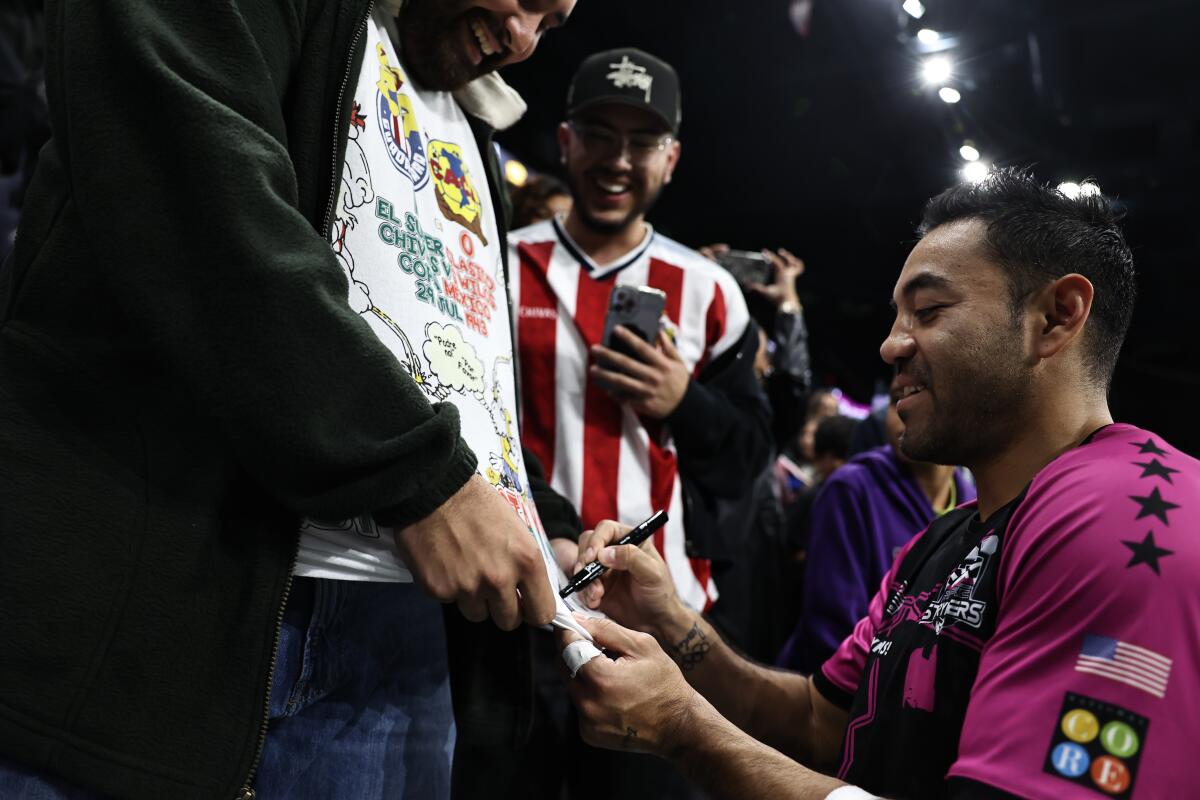
(Empire Strykers)
When Beckham joined the Galaxy 16 years ago, becoming the first major European star to sign with the league, it paved the way for players such as Thierry Henry, Robbie Keane, Wayne Rooney, Bastian Schweinsteiger, Frank Lampard, Steven Gerrard and Zlatan Ibrahimovic to follow, fueling a transition that saw Major League Soccer grow from a sleepy 12-team league with a media-rights agreement worth $8 million a season into the largest first-division league in the world, one with a 10-year, $2.5-billion broadcast deal.
Now a team owner, Beckham brought Lionel Messi, the most decorated player in history, to MLS in 2023, when the league drew nearly 11 million fans during the regular season. Only six leagues worldwide have a better average attendance. For Burum, 63, a wealthy real estate developer and philanthropist who is wound tighter than a golf ball and packs more energy than a Category 4 hurricane, there is a lesson there.
“They blazed a path that even a small guy like me in Ontario, California, can follow,” he said. “So we’re going to give it our best.”
Indoor soccer is a quick-paced sport that has more in common with ice hockey and futsal than the World Cup. Games consist of four 15-minute periods, with the clock stopping for dead balls. Teams play with five players and a goalkeeper. Substitutions, which are unlimited, happen on the fly, with players tumbling over the boards every 90 seconds or so. Any player who draws a blue card must spend two minutes in the penalty box, giving the other team a man-advantage power play.
Burum, a tireless proselytizer of the game with enthusiasm that is infectious, says he believes people will embrace the sport if exposed to it.
Voices
Commentary: Kylian Mbappe and Erling Haaland could surpass Messi and Ronaldo as greatest ever
Kylian Mbappe and Erling Haaland are soccer’s newest stars and one day their careers might be considered better than those of Lionel Messi and Cristiano Ronaldo.
“Get them to watch 20 minutes of indoor soccer, 20 minutes of outdoor soccer, and I think seven to eight out of 10 would rather watch the game of indoor professional soccer,” he said.
“You grow the game with fans, right? But the fans have to know you exist. Marco helps fans know we exist.”
Fabian, 34, will be well-rewarded if Burum is proven right, but he already has substantial skin in the game. Although he once had a market value of $7.75 million, his two-year contract with the Strykers isn’t close to seven figures, much less $7 million. “It’s closer to $100,000,” a team official said of a deal reportedly worth $25,000 a month for the six-month season, plus perks that include housing.
It’s believed to be the second-largest contract in league history, behind the $250,000 the San Diego Sockers paid Landon Donovan to play 10 games in 2018-19. And it’s particularly rich in a league where salaries range between $10,000 to $25,000 a season and many players work day jobs. Yet the real value lies in the Beckham-like clause that allows him to become a franchise owner someday.
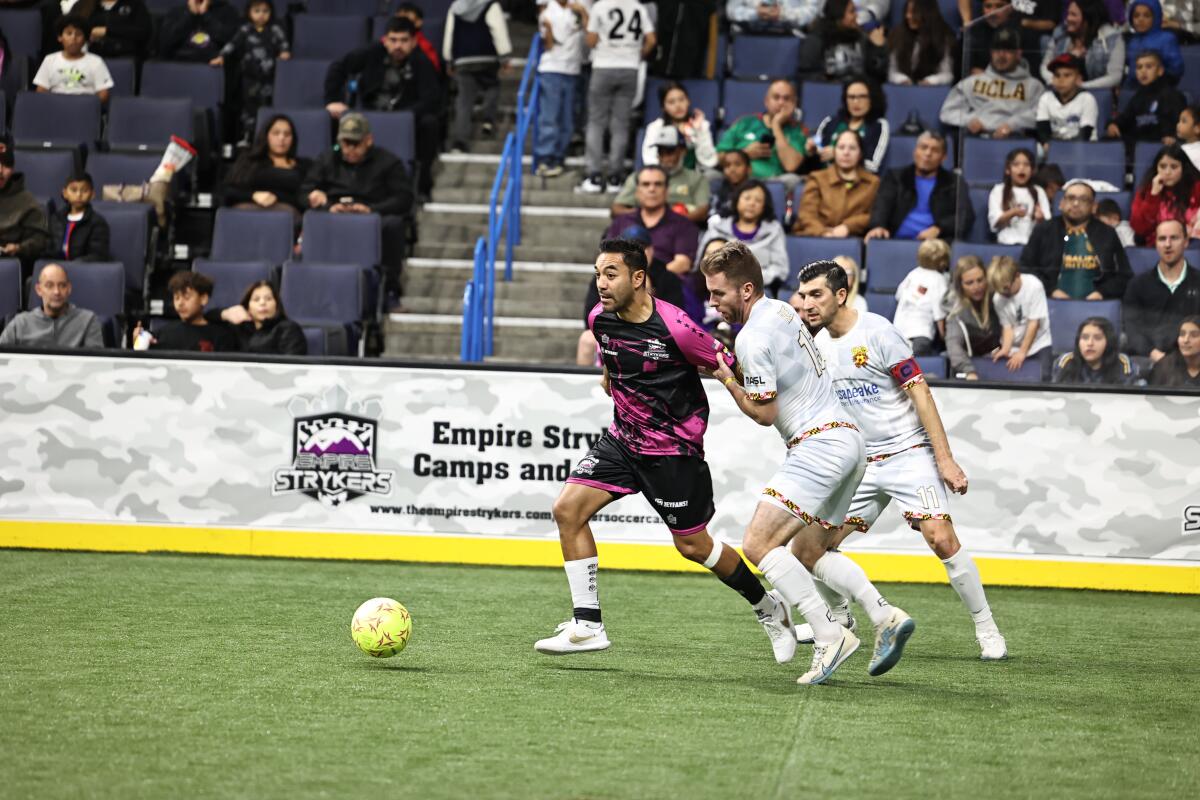
(Empire Strykers)
“Marco has an option to partner with me on a franchise or has an opportunity to have his own franchise,” Burum said. “It depends on how quickly we grow this sport and how many more of Marco’s friends are coming.”
Before MLS, indoor soccer was the most popular form of the game in the U.S. The 14-team Major Indoor Soccer League had TV deals with the USA Network, CBS and ESPN, among other broadcasters, and the St. Louis Steamers averaged 17,107 fans a game in 1981-82; among NBA and NHL teams, only the Edmonton Oilers, New York Rangers and Seattle SuperSonics drew better.
Yet despite its success the MISL was unstable, with bankruptcies and relocations causing the roster of teams to fluctuate wildly from season to season before the league folded in 1992 after 14 seasons.
The MASL, meanwhile, born as the Professional Arena Soccer League in 2008 and rechristened six seasons later, has struggled financially and organizationally. The league averaged just 2,172 fans a game last season and is drawing 2,219 early into this season. The streaming service Twitch is the league’s media rights partner.
As president of the 13-team league, with franchises spread from upstate New York to northern Mexico, Burum wants to recapture the sport’s former prominence. He’s lobbied to get the game included for the 2028 L.A. Olympics and he says he’s pushing for a new broadcast deal that would provide wider exposure. He sees Fabian — who was playing for Santa Coloma in tiny Andorra, his fifth country and sixth team in as many years before joining the Strykers — as a partner in that quest.
“My deal with Marco Fabian is a personal one,” he said. “You help me in soccer, and I’ll help you in business.”
So far Fabian, who admits he’s still learning the rules of indoor soccer, appears to be holding up his end of the deal. Although he’s played just half the Strykers’ six games, he ranks second on the team in goals (3) and assists (4). After scoring the team’s final goal in last week’s loss to Tacoma, he autographed a plush soccer ball and tossed it into the stands. Following the game Fabian, the only MASL player to record a goal and an assist in the Olympic Games, posed for dozens of selfies, visited with fans and did interviews in English and Spanish.
So save the pity. Fabian is right where he and Burum want him to be.
“I want to grow this league,” he said. “It’s a different soccer, but I want to try a different challenge in my life. And I’m happy to be here.”
⚽ You have read the latest installment of On Soccer with Kevin Baxter. The weekly column takes you behind the scenes and shines a spotlight on unique stories. Listen to Baxter on this week’s episode of the Corner of the Galaxy podcast.
